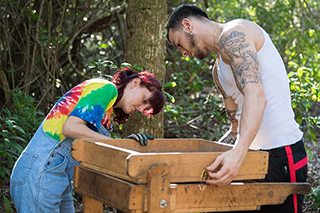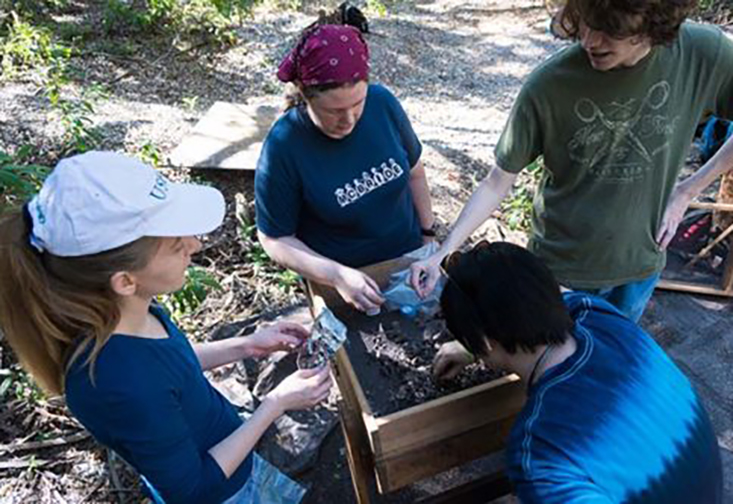Hidden deep in the heart of Weedon Island Preserve, a nearly 3,200-acre natural area on Tampa Bay, is an archaeological dig site that dates back 1,000 years.
Following a nearly invisible trail through groves of pine trees and ferns, the ground rises a bit, right before the dig site appears. This rise is called a midden, or shell mound.
Soft chatter from a group of students can be heard, followed by the scraping and brushing of earth and rapid “swoosh-swoosh” sounds coming from screens where dirt and small debris is sifted out.
Led by Dr. John Arthur, Associate Professor of Anthropology at USF St. Petersburg, 16 undergraduate anthropology students are working to uncover remnants of human history. Arthur couldn’t take all his students to the highlands of southwestern Ethiopia, where he has conducted research for 23 years on the history and prehistory of the Gamo people with Dr. Kathryn Weedman Arthur, Associate Professor of Anthropology at USFSP. The Weedon Island archaeological site is the next best substitute to provide a local hands-on experience for students to learn methods of archaeology.
“I wanted to take students out to a site that they could excavate and see if they actually liked archaeology,” said Arthur. “So, this is a perfect place. It is close to campus and it is accessible.”
Weedon Island is one of the most intact and famous archaeological sites in the southeast U.S. and has provided substantial evidence of early Florida inhabitants. The shell mounds being excavated by USFSP students are human-made piles of shell. Students are primarily uncovering “household” artifacts. Households include pottery, different types of modified shells and shell tools such as scrapers and hammers.
“Excavation allows me to practice the methods we are learning about,” said Shana Boyer, a senior majoring in Anthropology. “I’m a hands-on learner, so being able to actually excavate with my own hands has really enabled me to learn on a deeper level.”

From left: Shana Boyer and Andrew Haines adjusting a screen at the Weedon Island Archaeological site.
This is Boyer’s first time at the Weedon site but not her first time excavating. Previously she did work at the Gamble Plantation in Ellington, a Civil War era site that was a very different experience.
“It was really easy to get through multiple levels of soil in a day, as opposed to here, we may get through two levels a day,” said Boyer. “We were finding a lot of discarded nails and bottles. Here we are finding animal bone and shells.”
Another student at the site is Kristina Wood, a senior at USFSP majoring in Anthropology. This was not the first time Wood was involved in digging at Weedon Island. In 2014, she assisted a graduate student on her thesis project.
“I did all of it! I am pretty sure that I analyzed the entirety of the material that was dug during that year,” Wood said.
Over the course of her studies, Wood has volunteered more than 100 hours in the lab analyzing artifacts.
This hands-on archaeological experience is all part of an anthropology course called Seminar in Archaeological Methods and Theory. When not excavating, students read theory throughout the week. Then during lunch on the days they work at the site, they talk about the articles they read.
“This course was started at USFSP,” Arthur said. “No other university in the state has it.”
Arthur is also president of the non-profit organization Alliance for Weedon Island Archaeological Research and Education (AWIARE). The Alliance made headlines in 2011 when its members excavated a nearly 40-foot pre-historic canoe from the island’s shoreline. The canoe is the longest dugout found in Florida.
On this day, Wood stands over one of the three screens at the site. The one-quarter inch by one-eighth-inch screen, framed and held together by pieces of two-by-four in the shape of a ‘z,’ sifts out small shell particles and dirt, leaving the remaining shells and shell pieces intact. The shells are then placed in three-gallon Ziploc bags and labeled with detailed coordinates and other data, to be taken back to the archaeology lab at USFSP for analysis.
“We are very precise about where it was that we took artifacts out of the ground,” Wood said. “You will find different artifacts depending on the layer of soil they are found in.”
They also record everything with a camera, taking pictures of sediment striations, darkened areas in the soil where postholes once were, and exact locations where artifacts are found.
Both Wood and Boyer have plans to go onto graduate school and continue their work in anthropology. Boyer is planning to study paleoethnobotany at USF Tampa and Wood has her sights set on a graduate program in Liverpool, England, studying bioarchaeology and genetic research.
“I really enjoy all of it, which is why I had a hard time deciding what I wanted to focus on for grad school,” Boyer said. “I just find it all so interesting. There is a takeaway from everything in anthropology.”
(Article by Karlynd June, USFSP Content Specialist)
